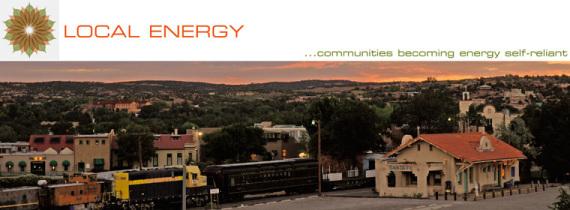Creative Ideas for Surviving Tough Economic Times
 Thursday, December 10, 2009 at 10:30AM
Thursday, December 10, 2009 at 10:30AM 
Mayor David Coss of Santa Fe and the nonprofit Creative Santa Fe are holding a forum to solicit ideas from the community on job creation and economic development. Here's the letter I just sent from Local Energy...I hope you like it!
Hi Kris and the Creative Team,
Here are my ideas for creating jobs and strengthening the local economy in Santa Fe:
In tough economic times, strengthening a local economy must focus on plugging leaks. That means looking at how to make the most of every dollar that is here, rather than looking to attract big outside capital. It’s not like there are huge capital flows out there ready to be captured anyway, other than the federal stimulus money everyone is so excited about. So sure, go after some of that “gummint” money if you want to, but remember that it is short-term and it was all borrowed from taxpayers in the first place.
Every community that has done an economic leakage study has shown the same four main leaks: Food, Interest, Insurance, and Energy. So our community economic plan MUST focus on these four items. We should begin by focusing on the ones that hold us hostage: Imported food and imported energy.
Plugging the energy-dollar leaks is easy, mostly because my nonprofit recently spent nearly two-million dollars researching how to do it. You begin by building technology-neutral platforms that allow local companies to provide thermal and electrical energy to their community. Thermal is easier to start with because it’s unregulated, and you can start small and interconnect the systems as you move forward. Every building that is heated using water-delivery (i.e. with hot-water radiators, baseboard, or radiant floor) can be easily modified with a Thermal Access Port that allows a third-party vendor to furnish heat to it. And there’s no monopoly on heat sales, so you don’t have to worry about the PNM’s of the world trying to shut this effort down.
Building the heat network is also a prerequisite to building the electric network, because generating electricity typically involves waste heat and you will need a place to dump it. For local electricity you will need a legal strategy, because as we’ve seen, the incumbent isn’t willing to allow new players to come in. But you CAN beat the monopoly if you are creative about it. Hint to City Council: Local electricity does NOT involve inviting a Baltimore-based company funded by a Wall-Street Bank to connect Chinese-made products to a monopoly power grid. What it does involve, as a first step, is creating a self-generation cooperative that works exclusively behind the meter, installing cooperatively owned power systems of all types and sizes. This allows you to begin right away putting in the locally owned generation that you will need as you prepare for step two, which involves (deep breath please) creating a municipal electric power system. Power for the system would come from (you guessed it) the self-generation cooperative, which would continue installing local generation strategically to reduce power imports and defer any needed line upgrades.
I’ll leave it to the Ag folks to solve the food localization strategy, but be sure that it involves a local greenhouse cooperative building climate-battery greenhouses with moveable radiant blankets for night-time protection. For this component, consider supporting local nonprofits like my own that have been researching and developing such efforts for years. We could really benefit from your support.
Many, many thanks for the opportunity to provide input, and all the best with the effort,
- Mark Sardella, Chairman
Local Energy, a 501(c)(3) charitable nonprofit
Hi Kris and the Creative Team,
Here are my ideas for creating jobs and strengthening the local economy in Santa Fe:
In tough economic times, strengthening a local economy must focus on plugging leaks. That means looking at how to make the most of every dollar that is here, rather than looking to attract big outside capital. It’s not like there are huge capital flows out there ready to be captured anyway, other than the federal stimulus money everyone is so excited about. So sure, go after some of that “gummint” money if you want to, but remember that it is short-term and it was all borrowed from taxpayers in the first place.
Every community that has done an economic leakage study has shown the same four main leaks: Food, Interest, Insurance, and Energy. So our community economic plan MUST focus on these four items. We should begin by focusing on the ones that hold us hostage: Imported food and imported energy.
Plugging the energy-dollar leaks is easy, mostly because my nonprofit recently spent nearly two-million dollars researching how to do it. You begin by building technology-neutral platforms that allow local companies to provide thermal and electrical energy to their community. Thermal is easier to start with because it’s unregulated, and you can start small and interconnect the systems as you move forward. Every building that is heated using water-delivery (i.e. with hot-water radiators, baseboard, or radiant floor) can be easily modified with a Thermal Access Port that allows a third-party vendor to furnish heat to it. And there’s no monopoly on heat sales, so you don’t have to worry about the PNM’s of the world trying to shut this effort down.
Building the heat network is also a prerequisite to building the electric network, because generating electricity typically involves waste heat and you will need a place to dump it. For local electricity you will need a legal strategy, because as we’ve seen, the incumbent isn’t willing to allow new players to come in. But you CAN beat the monopoly if you are creative about it. Hint to City Council: Local electricity does NOT involve inviting a Baltimore-based company funded by a Wall-Street Bank to connect Chinese-made products to a monopoly power grid. What it does involve, as a first step, is creating a self-generation cooperative that works exclusively behind the meter, installing cooperatively owned power systems of all types and sizes. This allows you to begin right away putting in the locally owned generation that you will need as you prepare for step two, which involves (deep breath please) creating a municipal electric power system. Power for the system would come from (you guessed it) the self-generation cooperative, which would continue installing local generation strategically to reduce power imports and defer any needed line upgrades.
I’ll leave it to the Ag folks to solve the food localization strategy, but be sure that it involves a local greenhouse cooperative building climate-battery greenhouses with moveable radiant blankets for night-time protection. For this component, consider supporting local nonprofits like my own that have been researching and developing such efforts for years. We could really benefit from your support.
Many, many thanks for the opportunity to provide input, and all the best with the effort,
- Mark Sardella, Chairman
Local Energy, a 501(c)(3) charitable nonprofit










